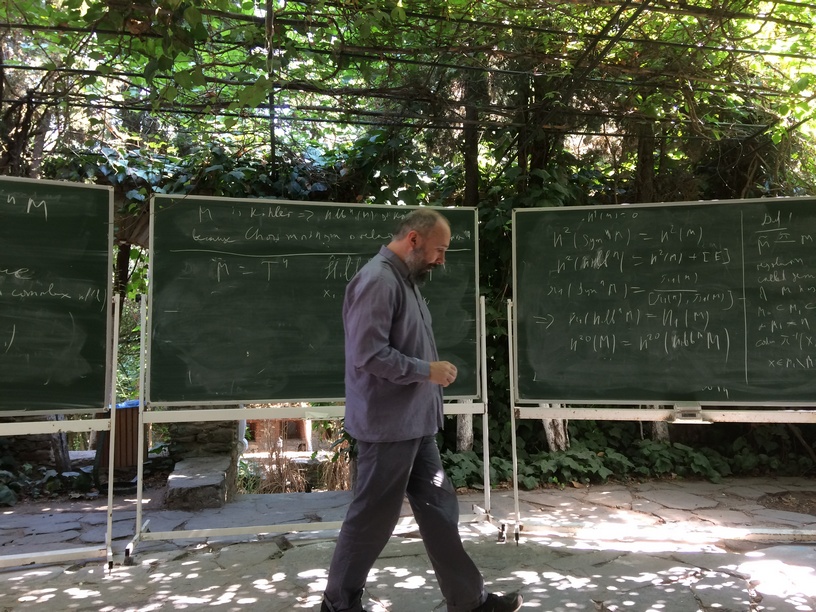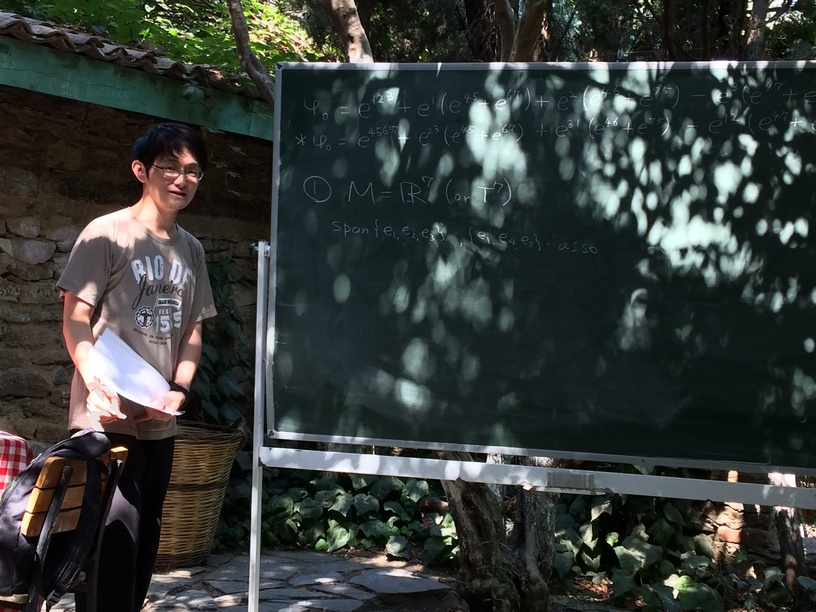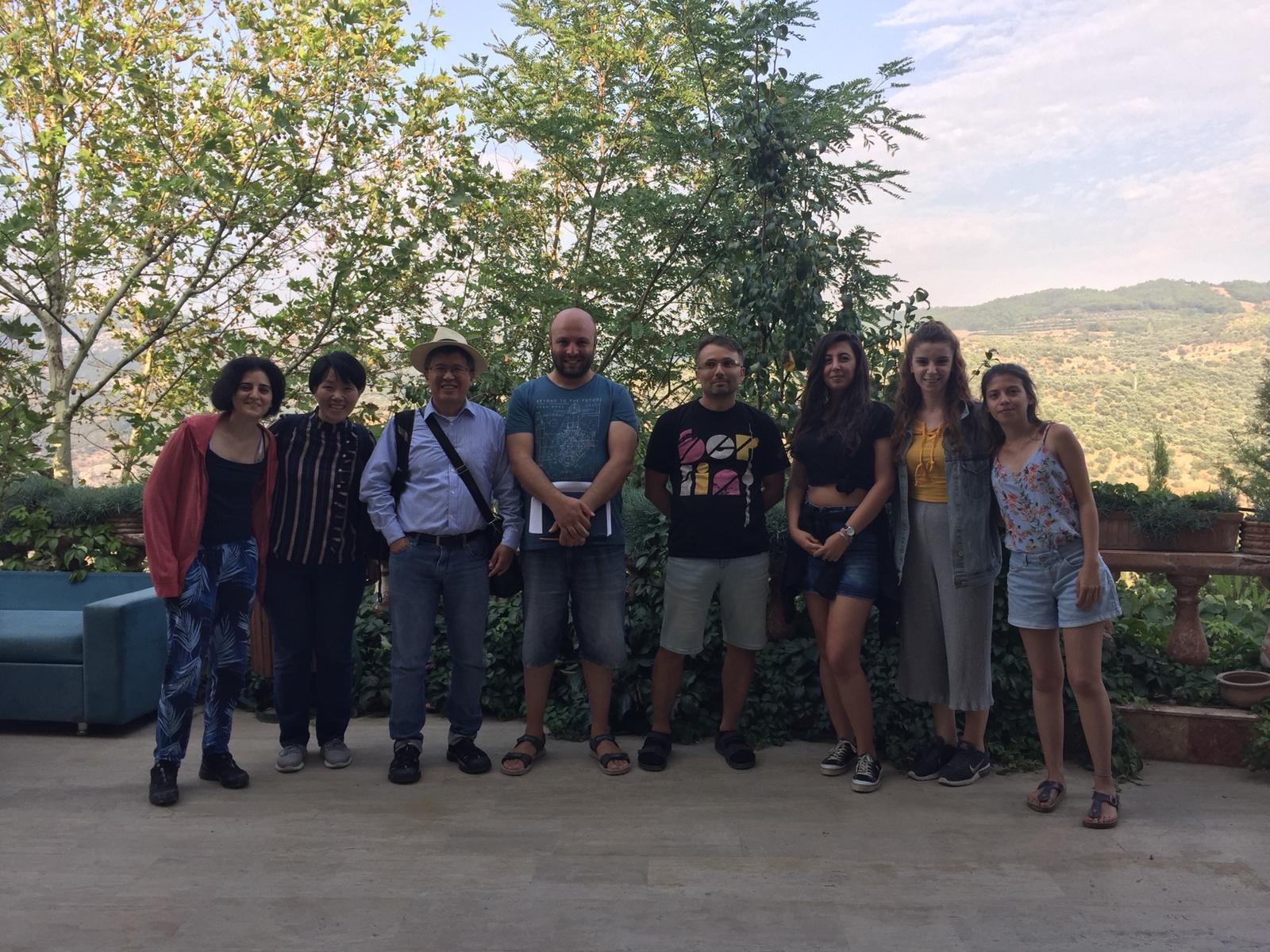| Geometry Main | 14 15a 15b 18 19 20a 20b 20c |
The 2nd GTSSGEOMETRY-TOPOLOGY SUMMER SCHOOL Nesin Mathematics Village, Şirince, İzmir
|
| TIME | SPEAKER | TITLE |
| Sep 9-15
8-10 |
Craig Van Coevering |
Special Metrics in Sasakian Geometry A
|
| Sep 9-13
10-12 |
Misha Verbitsky | Hyperkähler Manifolds |
| Sep 9-14
2:30-4 |
Kotaro Kawai | Calibrated submanifolds in G2 manifolds |
| Sep 9-14
4-5:30 |
Jongsu Kim | Generalization of Einstein metrics |
| Sep 9-15
10-12 |
Mehmet Kılıç | Metric Geometry |
| Sep 9-15 4-5:30 |
Özgür Kelekçi | Kähler Geometry A |
| Sep 9-15
5:30-7 |
Buket Can Bahadır | Partial Differential Equations (Sobolev and Hölder Spaces) A |
Second Week
| TIME | SPEAKER | TITLE |
| Sep 16-18
8-10 |
Craig Van Coevering | Special Metrics in Sasakian Geometry B |
| Sep 16-20
10-12 |
Lei Ni | Complex geometric analysis
Lecture Notes , Seminar |
| Sep 16-20
2:30-4 |
Yanyan Niu | Differential Harnack estimate on manifolds |
| Sep 16-22
4-5:30 |
Murat Savaş | Hyperbolic Geometry |
| Sep 16-18
5:30-7 |
Özgür Kelekçi
|
Kähler Geometry B
|
| Sep 16-22
7-8:30 |
Buket Can Bahadır |
Partial Differential Equations (Sobolev and Hölder Spaces) B
|
Seminar
| TIME | SPEAKER | TITLE |
| Sep 20 8:30 |
Mustafa Kalafat | Conformally Kähler surfaces and orthogonal holomorphic bisectional curvature |




Information
The 2nd GTSS will be held at the
Nesin Mathematical Village
in Şirince, İzmir.
There will be about 15 mini-courses of introductory nature, related to the Geometry-Topology research subjects.
In the middle of the week there is an excursion to the Ancient City of Ephesus and/or Kuşadası Beach.
Wifi info: Passwords are TermoS1! at the Library networks and zeytinlik for istasyon at the registration lobby.
Application
Graduate students, recent Ph.D.s and under-represented minorities are
especially encouraged to the summer school.
Partial financial support is available. Daily expenses including bed, breakfast, lunch, dinner is less than 20$.
Please fill out the application form to attend to the summer school.
Airport: İzmir Adnan Menderes Airport - ADB is the closest one.
Visas: Check whether you need a visa beforehand.

Abstracts
This course will begin with an introduction to Sasakian geometry, a type of metric contact structure which is an odd dimensional analogue of a Kähler structure on a complex manifold. We will then consider the problem of finding a special Sasakian metrics, such as Einstein, and more generally constant scalar curvature and extremal metrics.
Textbook or/and course webpage:
1. Boyer, Charles P.; Galicki, Krzysztof. Sasakian geometry. Oxford Mathematical Monographs. Oxford University Press, Oxford, 2008. xii+613 pp.
2. Futaki, Akito; Ono, Hajime; Wang, Guofang Transverse Kähler geometry of Sasaki manifolds and toric Sasaki-Einstein manifolds. J. Differential Geom. 83 (2009), no. 3, 585–635.
3. Collins, Tristan C.; Székelyhidi, Gábor. K-semistability for irregular Sasakian manifolds. J. Differential Geom. 109 (2018), no. 1, 81–109.
Prerequisites:
A first year graduated course in differential geometry should be sufficient. -->
In this lecture, we first give a survey of calibrated submanifolds in G2 manifolds. Then we present their deformation theories.
Textbook or/and course webpage:
1. K. Kawai, Deformations of homogeneous associative submanifolds in nearly parallel G2-manifolds, Asian J. Math. 21 (2017), 429-462.
2. K. Kawai, Second-order deformations of associative submanifolds in nearly parallel G2-manifolds, Q. J. Math. 69 (2018), 241-270.
3. J. D. Lotay, Associative Submanifolds of the 7-Sphere, Proc. Lond. Math. Soc. (3) 105 (2012), 1183-1214.
4. R. C. McLean, Deformations of Calibrated Submanifolds, Comm. Anal.Geom. 6 (1998), 705-747.
Prerequisites:
Linear Algebra, Riemannian Geometry
Kähler geometry has been an important area of differential geometry and attracted significant interest from both mathematics and mathematical physics research community. In this lecture series our aim is to provide an introduction to different aspects of Kähler geometry. We will start with a review of Riemannian geometry. Then emphasis will be on complex and Hermitian geometry which form the basis for Kähler manifolds. We will study several aspects of Kähler manifolds such as the Calabi-Yau theorem, Weitzenböck techniques, Calabi–Yau manifolds.
Textbook or/and course webpage:
A. Moroianu, “Lectures on Kähler Geometry”
Prerequisites:
Basic Differential Geometry (not a must but preferable)
I shall give a quick course on the complex/Kaehler geometry with emphasis of PDE methods.
Textbook or/and course webpage:
I shall distribute some notes. The students can start with books such as
Complex Manifolds, by J. Morrow and K. Kodaira, AMS.
Principles of of Algebraic Geometry, by Griffiths-Harris, John Wiley and Sons.
Differential Analysis on Complex Manifolds, by Wells. Springer.
Complex differential manifolds, by Zheng, AMS/IP.
Complex geometry, by Huybrechts, Springer.
Prerequisites:
Linear Algebra, Partial Differential Equations/Complex Analysis (not a must but preferable)
In this lecture series we present “Li-Yau-Hamilton“ type differential Harnack estimate on Riemannian manifolds and Kähler manifolds.
Textbook or/and course webpage:
1. Bennett Chow, Peng Lu and Lei Ni, Hamilton’s Ricci flow, Graduate Studies in Mathematics, 77. American Mathematical Society, Providence, RI; Science Press Beijing, New York, 2006.
2. B.Wilking, A Lie algebraic approach to Ricci flow invariant curvature condition and Harnack inequalities, J. reine angew. Math. (Crelle), 679 (2013), 223–247.
3. L. Ni and Y. Y. Niu, Sharp differential estimates of Li-Yau-Hamilton type for positive (p, p)-forms on Kähler manifolds. Comm. Pure Appl. Math., 64 (2011), 920–974.
Prerequisites:
Riemannian manifold, Kähler manifold (not a must but preferable)
Partial Differential Equations, Functional Analysis, Riemannian Geometry (not a must but preferable).
Level: Graduate, advanced undergraduate
Abstract: In this lecture series, our aim is to introduce Sobolev Spaces, and to present techniques and ideas from functional analysis to develop the theory. Since the solutions of partial differential equations are naturally found in Sobolev spaces, this theory proves to be a useful tool for several applications in partial differential equations, as well as giving us an opportunity for a different aproach to classical problems using the methods of functional analysis. We also would like to make an introduction to how these concepts can be aplied in the set up of Riemannian Manifolds., and give examples, such as Yamabe problem, where this aprooach played an important role.
Textbook or/and course webpage:
Evans, Lawrence C. - Partial differential equations. Second edition. Graduate Studies in Mathematics, 19. American Mathematical Society, Providence, RI, 2010.
Prerequisites: Temel Analiz bilgisi ve metrik uzaylara aşinalık.
Level: Graduate, advanced undergraduate
Abstract: Bu derste, uzunluk uzayları ve jeodezik uzaylar tanıtılacaktır. Ascoli Teorem'i ifade ve ispat edilecek ve bunun sonucu olarak bir ''proper'' metrik uzayda, sonlu uzunluğa sahip bir yolla birleştirilebilen iki nokta arasında, minimal uzunluğa sahip bir yolun var olduğu gösterilecektir. Daha sonra metrik uzaylarda bazı konvekslik kavramları incelenecektir. Language: TR
Textbook: Metric Spaces, Convexity and Nonpositive Curvature; Athanase Papadopoulos. A Course in Metric Geometry; Dmitri Burago, Yuri Burago, Sergei Ivanov.
In this lecture series we give an introduction to hyperbolic geometry with some discussion of other non-Euclidean systems. We generate useful volume and area formulas for tetrahedrons and triangles in low-dimensional hyperbolic space. Daily sections of the lecture are given below.
Description of the hyperbolic geometry models and the connection between them. Description of the general Mobius group. Characterization of the isometries of hyperbolic space. Geometry of hyperbolic triangles. Hyperbolic trigonometry. Hyperbolic area and the Gauss-Bonnet theorem.
Textbook or/and course webpage:
1. Anderson, James W. – Hyperbolic Geometry, Springer-Verlag, London, 2005.
2. Ratcliffe, John G., Foundations of Hyperbolic Manifolds, Graduate texts in Mathematics, 149, Springer, New York, 2006.
Prerequisites:
Linear Algebra
In this lecture series we review some generalizations of Einstein metrics. These are Ricci solitons, static spaces and warped-product Eınstein metrics. As a tool to approach these strucures, we start with some study on the so-called Codazzi tensors and then talk about harmonic curvature and harmonic Weyl curvature. After these, we apply the Codazzi tensor approach to study each of the above generalizations of Einstein metrics.
Textbook or/and course webpage:
1. A.L. Besse - Einstein manifolds, Chapter 16, Ergebnisse der Mathematik, 3 Folge, Band 10, Springer-Verlag, 1987.
2. G. Catino, C. Mantegazza, L. Mazzieri, A note on Codazzi tensors, Math. Ann. 362 (2015), No. 1-2, 629-638.
3. J. Kim. On a classification of 4-d gradient Ricci solitons with harmonic Weyl curvature, J. Geom. Anal. 27, (2017), no. 2, 986-1012.
Prerequisites:
Riemannian Geometry
Hyperkähler manifolds are manifolds with 3 complex structures satisfying quaternionic relations, and a torsion-free orthogonal connection preserving these complex structures. A number of objects arising in hyperkähler geometry are equipped with hyperkähler structure, such as moduli of vector bundles, deformation spaces, subvarieties and so on. This allows one to speak of “hyperkähler geometry”, similar to the usual complex algebraic geometry. I would explain basic properties of hyperkähler manifolds, give some examples and prove results about subvarieties.
Textbook or/and course webpage:
Besse, “Einstein manifolds”
Prerequisites:
Differential geometry, topology
Kalafat:
We show that a compact complex surface which admits a
conformally Kahler metric g of positive orthogonal holomorphic
bisectional curvature is biholomorphic to the complex projective
plane. In addition, if g is a Hermitian metric which is Einstein, then
the biholomorphism can be chosen to be an isometry via which g becomes
a multiple of the Fubini-Study metric. This is a joint work with
C.Koca.
Reference:
Kalafat, Mustafa; Koca, Caner -
Conformally Kähler surfaces and orthogonal holomorphic bisectional curvature.
Geom. Dedicata 174 (2015), 401–408.



Activities are supported by Nesin Mathematical Village and Turkish Mathematical Society